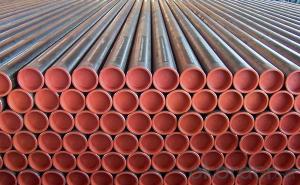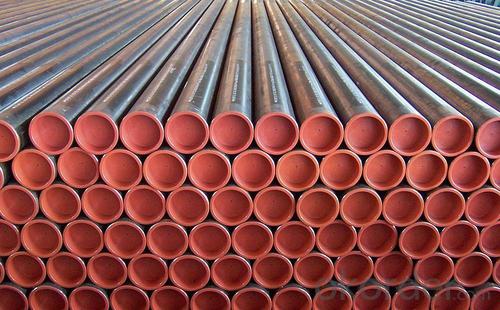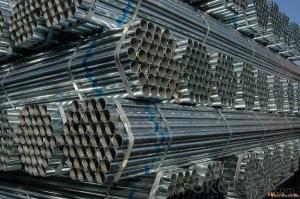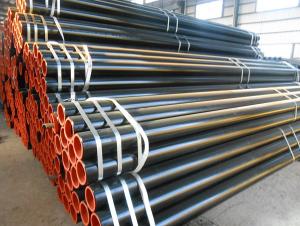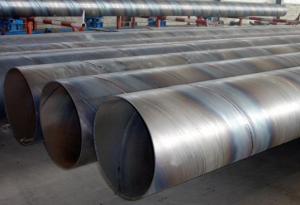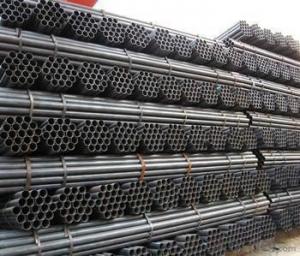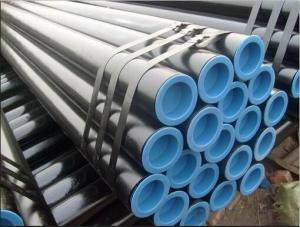ERW WELDED STEEL PIPE FOR OIL,GAS,WATER DELIVERY
- Loading Port:
- Tianjin
- Payment Terms:
- TT OR LC
- Min Order Qty:
- 20 m.t.
- Supply Capability:
- 20000 m.t./month
OKorder Service Pledge
OKorder Financial Service
You Might Also Like
Product Name | Longitudinally welded steel pipe / ERW Steel pipe / Carbon steel pipe/ HFW steel pipe | |
Size | OD | 4"-32"/114mm-813mm |
Thickness | 6.5mm-20mm | |
Length | 6m-23m | |
Steel Material | GR.B X42 X52 X56 L245 L290 L360 L415 S245 S290 S360 S390 S355JR S275 | |
Standard | API 5L PLS 1 | |
Usage | Oil Pipe, Casing Tube, Line Pipe and Fluid (Water, Gas) Transmission | |
Surface | Bared Black Painting, Anti-Corrosion Coating | |
Proctor | Plastic cap | |
Package | Bundles, Bulk | |
Inspection | With Hydraulic Testing, Ultrasonic testing or X-ray Test | |
Certificate | API and ISO9001;2000 | |
Date of Delivery | Less Than 15/20/25/30/40/50/60 Days According To The Quantity | |
Payment: | L/C or T/T | |
Port of Shipment | Xingang,China | |
- Q: Can steel pipes be used for oil and gas pipelines?
- Yes, steel pipes are commonly used for oil and gas pipelines due to their high strength, durability, and resistance to corrosion.
- Q: Are steel pipes suitable for underground industrial waste disposal?
- Steel pipes are often used for underground industrial waste disposal due to their durability and strength. They have the ability to withstand the harsh conditions underground, including moisture, pressure, and corrosion. Additionally, steel pipes are resistant to chemical reactions, making them suitable for handling various types of industrial waste. They can effectively transport and contain hazardous materials, ensuring the safety and protection of the environment and surrounding areas. Overall, steel pipes are considered a reliable and efficient option for underground industrial waste disposal.
- Q: How are steel pipes measured and labeled?
- Steel pipes are typically measured and labeled based on their outside diameter (OD) and wall thickness. The measurement is usually expressed in millimeters or inches. The label includes these dimensions, such as "2-inch OD, 1/8-inch wall thickness." Additionally, the length of the pipe may also be included in the labeling, ranging from standard lengths like 6 meters or 20 feet.
- Q: What is the difference between steel pipes and plastic pipes?
- Steel pipes are made from a strong and durable metal, while plastic pipes are made from synthetic materials like PVC or polyethylene. Steel pipes are typically used for high-pressure applications and in areas where strength and durability are key factors. On the other hand, plastic pipes are more lightweight, corrosion-resistant, and easier to install. They are commonly used for low-pressure applications and in areas where chemical resistance is important.
- Q: Can steel pipes be used for underground water supply systems?
- Indeed, underground water supply systems can utilize steel pipes. These pipes, being robust and resistant to corrosion, are well-suited for subterranean purposes. They possess the ability to endure high water pressure, facilitate effective water flow, and exhibit a lengthy lifespan. Nevertheless, it is imperative to guarantee the steel pipes are adequately coated and safeguarded against corrosion to avert any water supply contamination. Furthermore, due to their heavier nature in comparison to alternative materials, additional support may be necessary during installation. To identify any potential concerns and avoid leaks or harm to the underground water supply system, proper maintenance and regular inspections are of utmost importance.
- Q: How do steel pipes handle pressure surges?
- Steel pipes possess exceptional strength and durability, enabling them to effectively manage pressure surges. When pressure surges arise within a pipeline system, steel pipes exhibit the capability to withstand and absorb heightened forces without experiencing breakage or rupture. The commendable tensile strength of steel grants resistance against the pressure imposed upon the pipes, preventing deformation or collapse during sudden surges. Furthermore, steel pipes possess a commendable burst pressure rating, signifying their capacity to endure substantial pressure increases without succumbing to failure. Additionally, steel pipes are frequently engineered with thicker walls, bolstering their capacity to handle pressure surges. The increased wall thickness assists in distributing the augmented force evenly, thereby minimizing the possibility of localized stress and potential points of failure. Moreover, steel pipes are frequently employed in conjunction with fittings and valves specially designed to tackle pressure surges. These fittings and valves are composed of similar materials, ensuring compatibility and preserving the integrity of the pipeline system. All in all, steel pipes are excellently suited to manage pressure surges due to their strength, durability, and ability to endure high pressures. Their resistance to deformation, notable burst pressure rating, and compatibility with specialized fittings and valves render them a dependable choice for applications where pressure surges may arise.
- Q: What is the difference between internal lining and external coating of steel pipes?
- The difference between internal lining and external coating of steel pipes lies in their respective purposes and locations. Internal lining refers to the material applied inside the steel pipes to protect the inner surface from corrosion, abrasion, or other forms of damage. It acts as a barrier between the transported fluids or substances and the steel pipe, preventing them from coming into direct contact and causing deterioration. The internal lining is typically made of materials like epoxy, polyethylene, or cement mortar, depending on the specific requirements and the nature of the transported substances. It ensures the longevity and integrity of the steel pipe by reducing the chances of internal corrosion and minimizing the risk of contamination. External coating, on the other hand, is applied to the outer surface of the steel pipes. Its main purpose is to provide protection against external factors such as weathering, soil corrosion, and mechanical damage. The external coating acts as a shield, safeguarding the steel pipe from environmental conditions like moisture, UV radiation, chemicals, and physical impact. Common materials used for external coatings include fusion-bonded epoxy, polyethylene, polypropylene, or bitumen. The choice of coating depends on factors like the exposure conditions, temperature, and the type of soil or surroundings the steel pipe will encounter. In summary, while internal lining protects the inner surface of steel pipes from corrosion and damage caused by transported substances, external coating acts as a barrier against external elements and physical stresses. Both internal lining and external coating play vital roles in ensuring the durability and reliability of steel pipes in various applications, such as oil and gas pipelines, water supply systems, or industrial processes.
- Q: Can steel pipes be used for heat exchangers?
- Yes, steel pipes can be used for heat exchangers. Steel is a commonly used material for heat exchangers due to its high thermal conductivity and durability. It can efficiently transfer heat between two fluids, making it suitable for various industrial applications.
- Q: What are the different types of steel pipes available in the market?
- There are several different types of steel pipes available in the market, including carbon steel pipes, stainless steel pipes, alloy steel pipes, and galvanized steel pipes. Each type of steel pipe has its own unique properties and uses, making them suitable for various applications in industries such as construction, oil and gas, plumbing, and automotive.
- Q: Can steel pipes be used for heat transfer applications?
- Heat transfer applications can utilize steel pipes as they are a great option for transferring thermal energy from one location to another. Steel is known for its excellent heat conductivity, making it a popular choice in heating, ventilation, and air conditioning (HVAC) systems, industrial process heating, and steam distribution networks. The high thermal conductivity of steel ensures efficient heat transfer, effectively distributing heat throughout the system. Moreover, steel pipes possess remarkable strength and durability, enabling them to withstand high temperatures and pressures commonly encountered in heat transfer applications. In summary, steel pipes are a dependable and extensively employed solution for heat transfer purposes.
Send your message to us
ERW WELDED STEEL PIPE FOR OIL,GAS,WATER DELIVERY
- Loading Port:
- Tianjin
- Payment Terms:
- TT OR LC
- Min Order Qty:
- 20 m.t.
- Supply Capability:
- 20000 m.t./month
OKorder Service Pledge
OKorder Financial Service
Similar products
Hot products
Hot Searches
Related keywords
